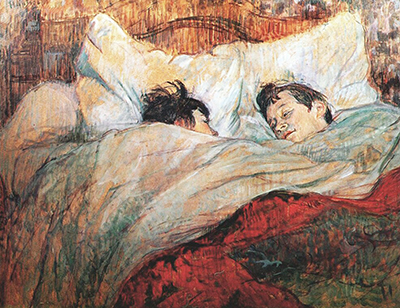From 1892 to 1894 Toulouse-Lautrec produced a series of paintings depicting scenes inside of brothels, where he actually lived for a while and became a companion of the women. He neither embellished nor judged the prostitutes but offered his version of this side of society for what it was - nothing more, nothing less.
In Bed (Le Lit) by Henri de Toulouse-Lautrec is one of four similar paintings, depicting women in bed, often presumed to be lesbian couples. This work is a post-impressionism oil painting on cardboard, completed in 1893 and this painting is widely considered as one of Toulouse-Lautrec’s most famous works. In this particular painting, there are two people lying in bed next to each other, gazing into each other’s eyes. One woman is on the left with the blankets up to her face. The second woman is on the right, her face covered up to her chin.
Even though many think the character on the right is a man it is actually a woman with short hair. The couple is facing each one another. The sheets and pillows are white and the headboard is brown. In the painting, there is also a red blanket over the sheets that can be seen at the bottom of the painting. Toulouse-Lautrec's ideals on homosexuality are well-documented. He was a firm defender of gay rights, which was a rarity in his time. It is believed that Toulouse-Lautrec chose to paint In Bed and other similar works because he was fascinated with the honesty and sensitivity of homosexuality rather than any sexual act itself.
In Bed was completed in 1893 and is currently on display at the Musée d’Orsay gallery in Paris, France. Toulouse-Lautrec had many influences throughout his short life. His early formative years were influenced by René Princetau and John Lewis Brown. Even though these two artists focused on animal portraitures, they had a definite influence on Lautrec’s sensibilities later on in his life.
In 1882 Toulouse-Lautrec studied under Léon Bonnat and worked under Fernand Cormon in 1883, with both artists have a major influence on his career. Toulouse-Lautrec was also influenced Japanese woodblock printmaking as well as being heavily influenced by the works of fellow artist Edgar Degas. Although Toulouse-Lautrec created many of his works on canvas he often chose to display his work on posters and is said to be the main influence for works from modern-day artists such as Andy Warhol.
Apart from the people who influenced Toulouse-Lautrec throughout his lifetime, he was also heavily influenced by his surroundings and much of his work was produced as a direct result of this. Toulouse-Lautrec moved easily among the dancers, the prostitutes, the artists, and the intellectuals of Montmartre during his life there, observing their everyday lives and capturing this in his own style to illustrate this raw beauty and sensitivity through his works.




